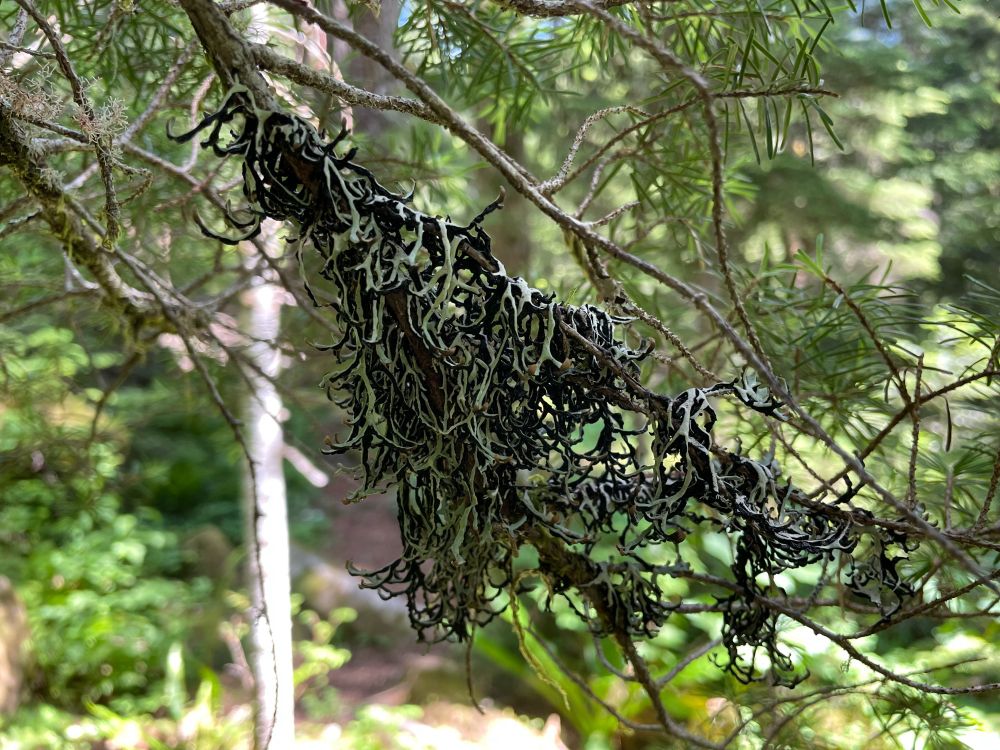Reposted by Joe DiMeglio
A fun collaboration led by Alan Fryday, @ddiazescandon.bsky.social, Tracy Thai and several colleagues from the Grootbos Nature Reserve in South Africa, with a bonus revisit of the class Lichinomycetes plus a novel, very strange ITS insertion link.springer.com/article/10.1...

The genus Caeruleum (Lichinomycetes, incertae sedis): A new species from South Africa and a preliminary revision of the genus in North America - Mycological Progress
We describe the new species Caeruleum terricola from Grootbos Private Nature Reserve in the Overstrand Municipality of Western Cape Province, South Africa. The new species occurs on consolidated soil ...
link.springer.com
July 7, 2025 at 11:33 PM
A fun collaboration led by Alan Fryday, @ddiazescandon.bsky.social, Tracy Thai and several colleagues from the Grootbos Nature Reserve in South Africa, with a bonus revisit of the class Lichinomycetes plus a novel, very strange ITS insertion link.springer.com/article/10.1...
Good times at MSA @uehlinglab.bsky.social @fungaljess.bsky.social



July 8, 2025 at 11:07 PM
Good times at MSA @uehlinglab.bsky.social @fungaljess.bsky.social
Reposted by Joe DiMeglio
BREAKING: Scientists are staging a “science fair” in the lobby of a Congressional building to tell elected officials about the critical knowledge the US will lose because their research grants have been canceled.
July 8, 2025 at 3:31 PM
BREAKING: Scientists are staging a “science fair” in the lobby of a Congressional building to tell elected officials about the critical knowledge the US will lose because their research grants have been canceled.
Reposted by Joe DiMeglio
A big revision for the Lecanora saligna group -- six new species in Lecanoropsis. This is a common group of crustose lichens in western North America and elsewhere in the Northern Hemisphere.


March 30, 2025 at 10:03 PM
A big revision for the Lecanora saligna group -- six new species in Lecanoropsis. This is a common group of crustose lichens in western North America and elsewhere in the Northern Hemisphere.
Reposted by Joe DiMeglio
I'm happy to share that @wyowildbotany.bsky.social and I have published a report on the status of federally listed and recently delisted plants in WA.
We report on population trends and synthesize research on some of Washington's rarest plants.
www.dnr.wa.gov/publications...
We report on population trends and synthesize research on some of Washington's rarest plants.
www.dnr.wa.gov/publications...

March 25, 2025 at 5:22 AM
I'm happy to share that @wyowildbotany.bsky.social and I have published a report on the status of federally listed and recently delisted plants in WA.
We report on population trends and synthesize research on some of Washington's rarest plants.
www.dnr.wa.gov/publications...
We report on population trends and synthesize research on some of Washington's rarest plants.
www.dnr.wa.gov/publications...
Reposted by Joe DiMeglio
"What has made our universities the greatest in the world, however, is not just the quality of our undergraduate education, but our ability to fulfill one of the central quests of modern life: the production of new knowledge thru discoveries that change the world."
www.nytimes.com/2025/03/24/o...
www.nytimes.com/2025/03/24/o...

Opinion | Universities Gave Us the iPhone, the Jet Engine and Gatorade. We’re Tossing That Away.
The postwar compact on research that powered America’s economic and military dominance is under threat.
www.nytimes.com
March 24, 2025 at 12:32 PM
"What has made our universities the greatest in the world, however, is not just the quality of our undergraduate education, but our ability to fulfill one of the central quests of modern life: the production of new knowledge thru discoveries that change the world."
www.nytimes.com/2025/03/24/o...
www.nytimes.com/2025/03/24/o...
Reposted by Joe DiMeglio
Pannaria oregonensis is a rare species endemic to moist lowland habitats of northwest North America, seen here on Hooker’s willow in a costal dune complex on the central Oregon coast.

March 21, 2025 at 3:54 AM
Pannaria oregonensis is a rare species endemic to moist lowland habitats of northwest North America, seen here on Hooker’s willow in a costal dune complex on the central Oregon coast.
Reposted by Joe DiMeglio
Orchid Bee, Colombia #BlueMonday
Males (like this) collect volatile chemicals, from orchids and other sources, to create complex scents to impress females. They collect chemicals with their front legs, transfer them to the middle legs, then finally into storage pockets in the enlarged rear legs.
🐙🌿📷
Males (like this) collect volatile chemicals, from orchids and other sources, to create complex scents to impress females. They collect chemicals with their front legs, transfer them to the middle legs, then finally into storage pockets in the enlarged rear legs.
🐙🌿📷

March 17, 2025 at 6:46 PM
Orchid Bee, Colombia #BlueMonday
Males (like this) collect volatile chemicals, from orchids and other sources, to create complex scents to impress females. They collect chemicals with their front legs, transfer them to the middle legs, then finally into storage pockets in the enlarged rear legs.
🐙🌿📷
Males (like this) collect volatile chemicals, from orchids and other sources, to create complex scents to impress females. They collect chemicals with their front legs, transfer them to the middle legs, then finally into storage pockets in the enlarged rear legs.
🐙🌿📷
Reposted by Joe DiMeglio

March 15, 2025 at 2:04 AM
Reposted by Joe DiMeglio
Gabura insignis is a unique hypercoastal cyanolichen in the Pacific Northwest distinguished by its wrinkled warty isidiate thallus that greatly expands when wet, seen here in a dry state growing on conifer twigs at the mouth of the Salmon River, Lincoln County Oregon.

March 15, 2025 at 3:35 AM
Gabura insignis is a unique hypercoastal cyanolichen in the Pacific Northwest distinguished by its wrinkled warty isidiate thallus that greatly expands when wet, seen here in a dry state growing on conifer twigs at the mouth of the Salmon River, Lincoln County Oregon.
Reposted by Joe DiMeglio
Letharia columbiana is a common endemic wolf lichen in the inland Northwest. It is distinguished by the chartreuse colored thallus from vulpinic acid and the prominent brown apothecia, seen here near Cottonwood Meadow Lake in Fremont-Winema National Forest, Lake County, Oregon.


March 12, 2025 at 3:35 AM
Letharia columbiana is a common endemic wolf lichen in the inland Northwest. It is distinguished by the chartreuse colored thallus from vulpinic acid and the prominent brown apothecia, seen here near Cottonwood Meadow Lake in Fremont-Winema National Forest, Lake County, Oregon.
Reposted by Joe DiMeglio
Pseudocyphellaria rainierensis is a specklebelly lichen restricted to ancient stands of old-growth and endemic to the Pacific Northwest temperate rainforest, seen here along the Ohanapecosh River, Lewis County, Washington.


March 11, 2025 at 3:59 AM
Pseudocyphellaria rainierensis is a specklebelly lichen restricted to ancient stands of old-growth and endemic to the Pacific Northwest temperate rainforest, seen here along the Ohanapecosh River, Lewis County, Washington.
Reposted by Joe DiMeglio
Parmelina coleae is a epiphytic lichen characteristic of the Mediterranean type climate of the California Floristic Province, seen here growing on an ancient Garry oak at the northern edge of its range at Upper Table Rock in Jackson County, Oregon.

March 9, 2025 at 5:00 AM
Parmelina coleae is a epiphytic lichen characteristic of the Mediterranean type climate of the California Floristic Province, seen here growing on an ancient Garry oak at the northern edge of its range at Upper Table Rock in Jackson County, Oregon.
Reposted by Joe DiMeglio
Ricasolia amplissima ssp. amplissima occurs only as a dendriscocauloid cyanomorph in southern Oregon, seen here growing on a horizontal branch of an ancient Garry oak in a lichen rich oak savannah near Antelope Creek in the foothills of the Cascade Mountain of Jackson County.


March 7, 2025 at 4:17 AM
Ricasolia amplissima ssp. amplissima occurs only as a dendriscocauloid cyanomorph in southern Oregon, seen here growing on a horizontal branch of an ancient Garry oak in a lichen rich oak savannah near Antelope Creek in the foothills of the Cascade Mountain of Jackson County.
Reposted by Joe DiMeglio
Cetrelia cetrarioides is an uncommon rag lichen living on red alder in low elevation riparian forests in the Pacific Northwest. Distinguished by pseudocyphellae on the upper & lower surfaces & elongate soralia along smooth thallus margins. Seen here along Mill Creek in downtown Turner, Oregon.


March 6, 2025 at 4:21 AM
Cetrelia cetrarioides is an uncommon rag lichen living on red alder in low elevation riparian forests in the Pacific Northwest. Distinguished by pseudocyphellae on the upper & lower surfaces & elongate soralia along smooth thallus margins. Seen here along Mill Creek in downtown Turner, Oregon.
Reposted by Joe DiMeglio
Nephroma tropicum is a commonly encountered kidney lichen in the rainforests of the Pacific Northwest, distinguished among local Nephroma species by the abundant marginal lobules. Seen here along the Nisqually River in the Longmire Springs area of Mount Rainier National Park, Washington.


March 4, 2025 at 4:21 AM
Nephroma tropicum is a commonly encountered kidney lichen in the rainforests of the Pacific Northwest, distinguished among local Nephroma species by the abundant marginal lobules. Seen here along the Nisqually River in the Longmire Springs area of Mount Rainier National Park, Washington.
Reposted by Joe DiMeglio
We've returned one of England’s rarest lichens to its historic home🏠
Scrambled Egg Lichen has been reintroduced to Norfolk from Cornwall via a trial translocation🍳
Thanks to Cornwall Wildlife Trust & Norfolk Wildlife Trust, with funding from Natural England
Learn more
👉 bit.ly/4hWieOP
Scrambled Egg Lichen has been reintroduced to Norfolk from Cornwall via a trial translocation🍳
Thanks to Cornwall Wildlife Trust & Norfolk Wildlife Trust, with funding from Natural England
Learn more
👉 bit.ly/4hWieOP

he Rare Lichen that Travelled from Cornwall to Norfolk
An incredible story of returning one of England’s rarest lichens to its historic home – more than 350 miles away.
bit.ly
February 28, 2025 at 2:09 PM
We've returned one of England’s rarest lichens to its historic home🏠
Scrambled Egg Lichen has been reintroduced to Norfolk from Cornwall via a trial translocation🍳
Thanks to Cornwall Wildlife Trust & Norfolk Wildlife Trust, with funding from Natural England
Learn more
👉 bit.ly/4hWieOP
Scrambled Egg Lichen has been reintroduced to Norfolk from Cornwall via a trial translocation🍳
Thanks to Cornwall Wildlife Trust & Norfolk Wildlife Trust, with funding from Natural England
Learn more
👉 bit.ly/4hWieOP
Reposted by Joe DiMeglio
Reposted by Joe DiMeglio
Excited to see how this goes. I helped the Plantlife team dig in the thalli…


February 28, 2025 at 11:06 AM
Excited to see how this goes. I helped the Plantlife team dig in the thalli…
Reposted by Joe DiMeglio
Spend your money as if it were your vote tomorrow Feb. 28 (and everyday in my mind). Our democracy and our economy (our ability to make enough to survive) depends on it.
Friday, Feb 28 2025.
BOYCOTT BUYING EVERYTHING MAJOR.
Buy local. Eat local. Have a day of savings. Make Oligarchs cry.
BOYCOTT BUYING EVERYTHING MAJOR.
Buy local. Eat local. Have a day of savings. Make Oligarchs cry.
February 27, 2025 at 7:49 PM
Spend your money as if it were your vote tomorrow Feb. 28 (and everyday in my mind). Our democracy and our economy (our ability to make enough to survive) depends on it.
Reposted by Joe DiMeglio
I often imagine crustose lichens as alien landscapes. A close up pic of a Porpidia species #lichen. #Newfoundland, Canada. #fungi

February 28, 2025 at 2:21 PM
I often imagine crustose lichens as alien landscapes. A close up pic of a Porpidia species #lichen. #Newfoundland, Canada. #fungi
Reposted by Joe DiMeglio
Postdocs and PhD students hit hard by Trump’s crackdown on science

Postdocs and PhD students hit hard by Trump’s crackdown on science
As US federal grants remain frozen and budget cuts loom, anxiety and fear grip early-career researchers.
www.nature.com
February 25, 2025 at 7:45 PM
Postdocs and PhD students hit hard by Trump’s crackdown on science
Reposted by Joe DiMeglio
How about the specimen of Sphaerophorus! I am learning towards S. venerabilis, but you can set us straight. It's from Mary's Peak in the Coastal Range of Oregon.

February 25, 2025 at 2:25 AM
How about the specimen of Sphaerophorus! I am learning towards S. venerabilis, but you can set us straight. It's from Mary's Peak in the Coastal Range of Oregon.
Reposted by Joe DiMeglio
Hypogymnia duplicata, old-growth yellow cedar swamp, Dingford Creek trail, Alpine Lakes Wilderness, WA.

February 22, 2025 at 8:51 PM
Hypogymnia duplicata, old-growth yellow cedar swamp, Dingford Creek trail, Alpine Lakes Wilderness, WA.
Reposted by Joe DiMeglio
And I though Lycoperdon perlartum (Common puffball) was saprobic. This study shows it forms ECM relationships with populus and may improve their resistance to drought.
link.springer.com/article/10.1...
link.springer.com/article/10.1...

Lycoperdon perlatum from a coniferous forest forms an ectomycorrhizal relation with and increases drought resistance of Populus × canadensis ‘Zhongliao 1’ - Symbiosis
Plant–fungal symbiotic associations benefit initial plant adaptation to droughty terrestrial ecosystems. Although information on mycorrhizal and endophytic fungi in drought-resistant mechanisms in cro...
link.springer.com
February 23, 2025 at 3:51 AM
And I though Lycoperdon perlartum (Common puffball) was saprobic. This study shows it forms ECM relationships with populus and may improve their resistance to drought.
link.springer.com/article/10.1...
link.springer.com/article/10.1...


